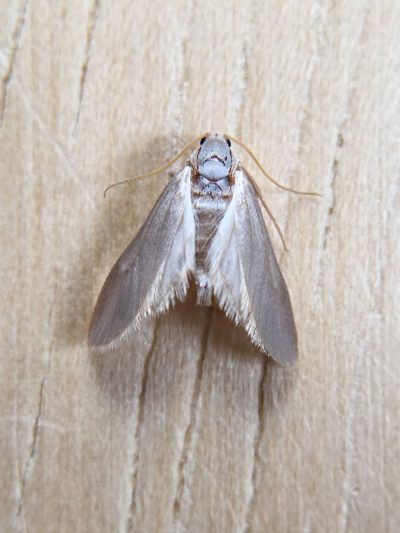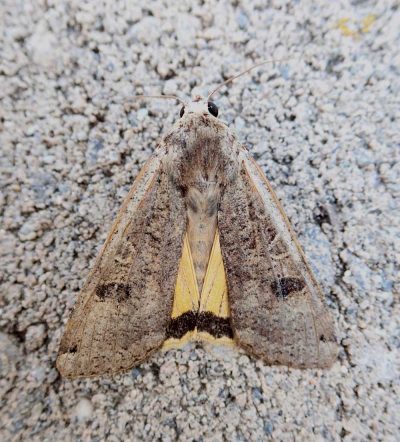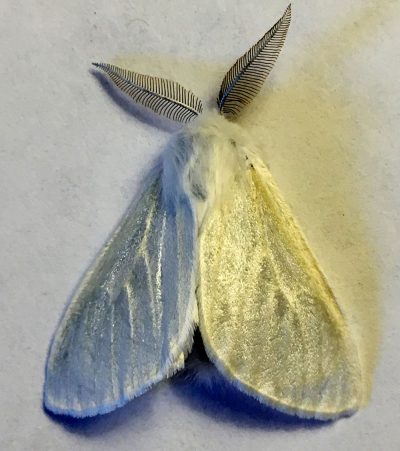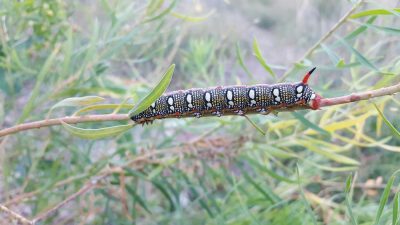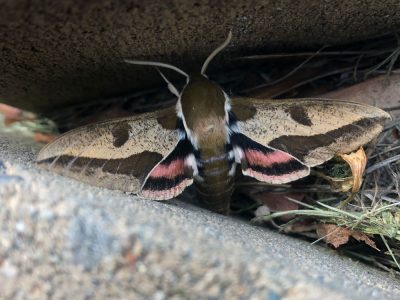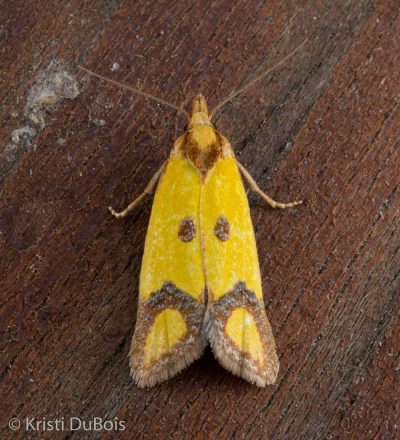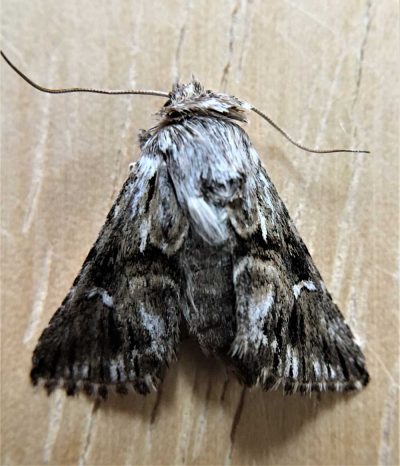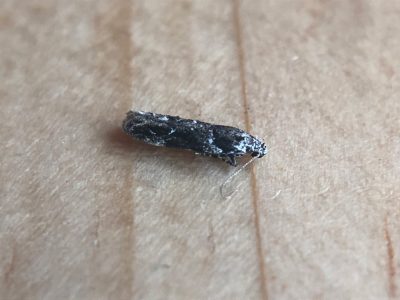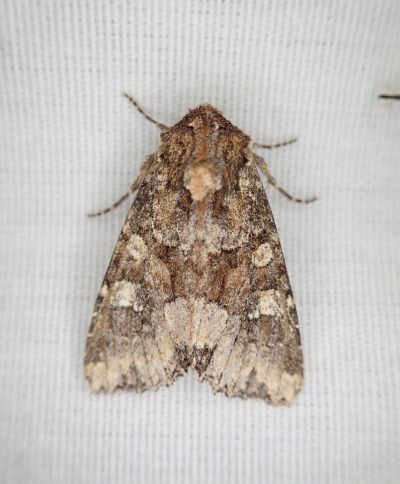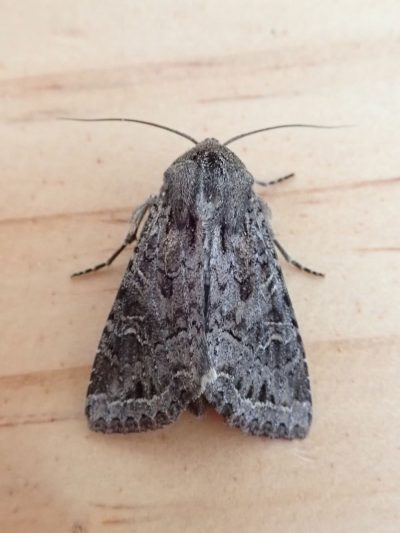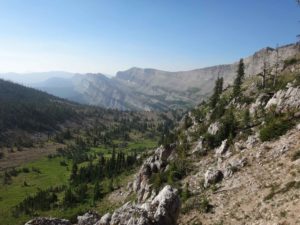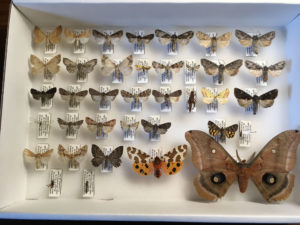By: Carrie Voss, Mat Seidensticker, and Kate Stone
Since 2017, we have collected adult moths to assess species diversity. We researched information about the habitat that these species use, like which plants the larvae eat and which nectar sources nourish adults. In this report, we will discuss the non-native and native pest moth species that we encountered.
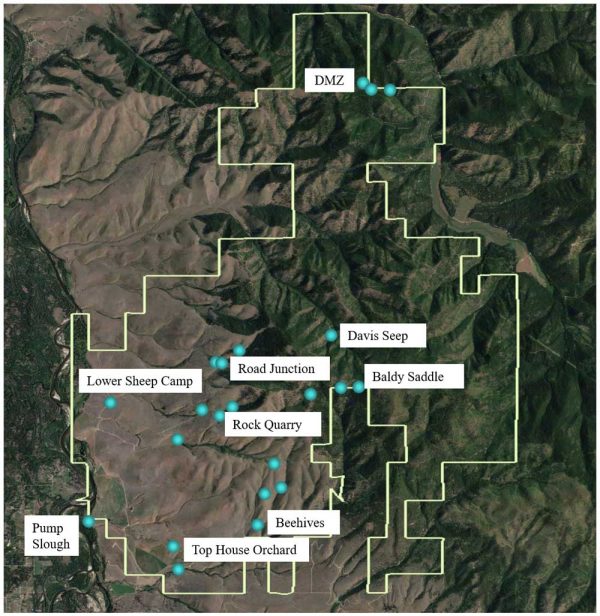
Water veneer (Acentria ephemerella)
We collected the water veneer in 2018 at our lower Sheep Camp site (Figure 1). It was introduced to North America in eastern Canada during the 1920s. Since then the water veneer has spread into the northeastern United States, where it appeared to reduce exotic Eurasian watermilfoil (Myriophyllum spicatum) infestations. Consequently, land managers continue to use it as a biocontrol agent for Eurasian watermilfoil. The larvae also feed on pondweeds (Potomogeton spp.) and Canadian waterweed (Elodea canadensis). According to the MPG Species Diversity Report, they do not have Eurasian watermilfoil but Canadian waterweed and two Potomogeton species do occur, which likely explains the presence of the water veneer. The potential for water veneer larvae to cause damage to these plants by boring into and girdling the stems suggests we should conduct monitoring for this moth in areas on the ranch where pondweeds and Canadian waterweed occur. So far, we have just found this one specimen and it is a new record for Montana.
Large yellow underwing (Noctua pronuba)
After its accidental introduction to North America in 1979, the large yellow underwing spread across the continent and reached the West Coast around 2001. The larvae feed on a variety of grasses and herbaceous vegetation. Populations exhibit epidemic outbreaks on agricultural crops like alfalfa, mixed hay and small grains. We observe this moth across MPG Ranch and at multiple sites throughout the Missoula and Bitterroot Valleys. An outbreak could potentially damage alfalfa and various native grasses/herbaceous vegetation on MPG Ranch.
White satin moth (Leucoma salicis)
Around 1920, the white satin moth was introduced to the east and west coasts. Since then it has spread widely across North America. It feeds on plants in the Salicaceae family, particularly favoring quaking aspen (Populus tremuloides) and hybrid poplar species. The larvae may consume entire leaves. Repeated feeding may cause branches or whole trees to die. We see single or few individuals while sampling, suggesting that they may not cause major or widespread damage here.
Leafy spurge hawkmoth (Hyles euphorbidae)
Land managers introduced the leafy spurge hawkmoth from Eurasia in 1974 as a biological control agent for leafy spurge (Euphorbia esula). Since its release, the hawkmoth spread northward into Canada and throughout large parts of the western United States. This moth occurs across MPG Ranch and at other sites with leafy spurge infestations in the Missoula and Bitterroot Valleys. Because the larvae only feed on leafy spurge, this species does not pose a risk of damaging native plants. Adult hawkmoths feeding on nectar could benefit native plants by pollination.
Sulphur knapweed moth (Agapeta zoegana)
In the 1980s, land managers introduced the sulphur knapweed moth as a biological control agent for knapweeds (Centaurea spp.) in the western United States. Spotted knapweed (Centaurea stoebe) and diffuse knapweed (Centaurea diffusa) are the exotic knapweeds of most concern. The larvae mine into roots and may cause moderate damage. Sulphur knapweed moths occur across MPG Ranch and in other areas infested with knapweed throughout the Missoula and Bitterroot Valleys.
Toadflax brocade moth (Calophasia lunula)
Beginning in 1962, land managers introduced the toadflax brocade moth as a biocontrol agent for exotic toadflax (Linaria spp.) in Ontario, Canada. It was later introduced in 1968 near Missoula, Montana. There are three exotic species of toadflax on MPG Ranch: dalmatian toadflax (Linaria dalmatica), Moroccan toadflax (Linaria maroccana), and yellow toadflax (Linaria vulgaris, MPG Species Diversity Report). Since the toadflax brocade moth larvae only feed on toadflax, we do not expect this moth to damage native plants. Also, nectar feeding adults are helpful pollinators.
Lesser budworm (Recurvaria nanella)
Little information exists for the lesser budworm. We know it came from Eurasia and feeds on fruit trees, primarily Malus and Prunus species. Larvae mine the leaves where they overwinter and then feed on emerging buds in the spring. We have collected one specimen of the lesser budworm at the beehives near Whaley draw (Figure1). This species is also known to feed on serviceberry (Amelanchier spp.) and hawthorn (Crataegus spp.) which may explain its presence near Whaley draw. Most outbreaks are documented on domestic fruit trees and there is little evidence to suggest that these moths would cause damage to native plants like serviceberry.
Native Moths – Potential Pests?
Some of the native moths that we observe are potential pest species. Most concerning are cutworm moths. Larvae of cutworm moths hide in soil or litter during the day and emerge at night to feed on plant stems and seedlings, cutting them down at the base. High larval densities can cause significant damage to crops and other herbaceous vegetation. In 2014-2015, Montana experienced a statewide outbreak of army cutworms (Euxoa auxiliaris). This outbreak caused serious damage throughout the state. On MPG Ranch, the outbreak dealt a severe setback to restoration efforts, but we’ve rarely encountered army cutworms since 2017.
We also find cutworm moths in the genus Apamea. To date, we have collected thirteen species of Apamea cutworm moths but only two have potential to cause significant damage to vegetation. One of these species is the yellow-headed cutworm (Apamea amputatrix, below). We observe this moth across MPG Ranch and at multiple sites throughout the Missoula and Bitterroot Valleys. It prefers grasses, but during outbreaks it can spread into various herbaceous plants, hardwood shrubs, or agricultural crops. It may also attack young fruit trees.
We also frequently encounter the glassy cutworm (Apamea devastator, below) on MPG Ranch. When major outbreaks occur, this moth can cause serious damage to various grain and grass crops and herbaceous plants.
Spruce budworms (Choristoneura spp.)
Members of the genus Choristoneura, like the western spruce budworm (C. occidentalis) are destructive defoliators in coniferous forests. We cannot identify these moths to species from photos and they also exhibit closely matched DNA barcodes. Consequently, we often categorize them into the spruce budworm complex. Our DNA barcoding identifies most specimens as the Jack pine budworm (C. pinus). Although it is possible that the Jack pine budworm occurs here, it’s known range and tree species preferences renders our DNA barcoding suspect. Collecting more specimens and performing genitalia dissections would help clarify this identification.
We frequently observe many budworm moths at light sheets in July and early August. These moths are damaging trees and have the potential for a serious outbreak affecting conifer forest habitats on MPG Ranch. Budworms are predominantly regulated by natural predators and adverse weather conditions. Cold temperatures in early spring and summer can keep populations low by killing larvae. Natural enemies like squirrels, chipmunks, various songbirds, and other insects also help keep larval populations in check during cooler weather. During prolonged periods of warm, dry weather, the larvae can develop much faster, potentially causing outbreaks that predators cannot significantly reduce. Aerially applied insecticides can be effective but are costly and risky to other wildlife. Ongoing forest management like thinning and reduction of understory regeneration is the most effective long-term strategy for mitigating tree losses from spruce budworm outbreaks.
Download the Dispatch: Non-Native and Native Pest Moths, May 12, 2020 (PDF)

